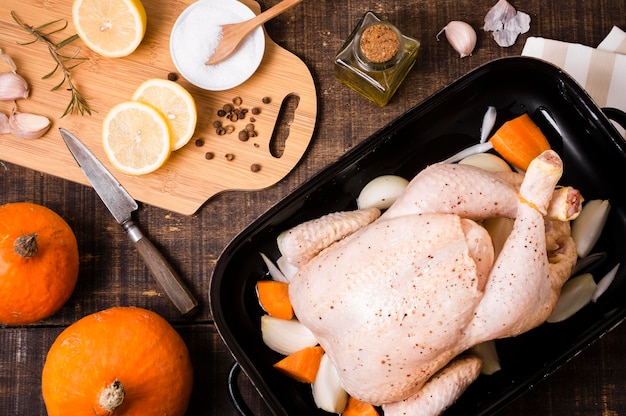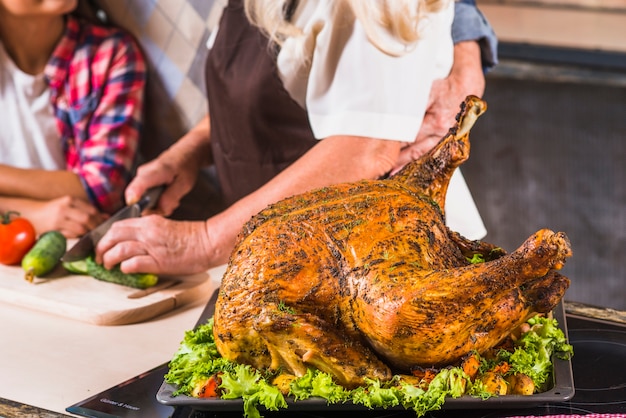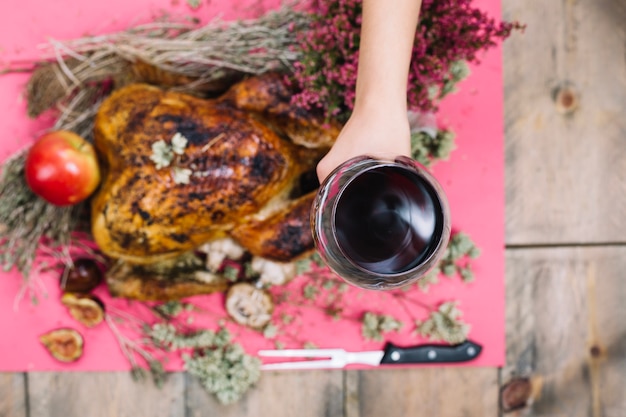A roast chicken, with its crispy skin and tender meat, is a real crowd-pleaser. It's a classic dish that evokes feelings of warmth and comfort. But, the thought of roasting a whole chicken can be a bit daunting, especially if you're a beginner. You might worry about undercooking or overcooking, ending up with dry meat or a burnt exterior. Fear not! I'm here to guide you through the process, sharing my secrets to achieving a perfectly roasted chicken, every time.
I've been roasting chickens for years, and I've learned a few things along the way. From choosing the right chicken to mastering the art of basting, I've got you covered. This guide will walk you through every step, from prepping the chicken to serving it up beautifully. So, grab a cuppa, settle in, and let's get cooking!
(Part 1) Choosing and Prepping Your Bird

Selecting the perfect chicken
The first step to a delicious roast chicken is choosing the right bird. I usually go for a whole chicken, weighing around 3-4 pounds. This is the perfect size for a family meal with enough leftovers for sandwiches or a hearty salad. When selecting your chicken, look for one with plump breasts and firm legs. Avoid any chickens that have discoloration or an unpleasant smell.
Prepping the Chicken for Roasting
Once you've chosen your chicken, it's time to prep it for roasting. Start by patting the chicken dry with paper towels. This helps the skin crisp up beautifully in the oven. Next, rub the chicken liberally with salt and pepper. Don't be shy with the seasoning, it's the foundation of a flavorful roast. You can also add other seasonings, like garlic powder, paprika, or even a bit of cayenne pepper for a touch of heat.
The Art of Trussing (Optional)
Trussing the chicken is a step that helps the bird cook evenly and keeps the legs from drying out. It's not essential, but it does enhance the final result. To truss a chicken, you'll need kitchen twine. Tie the legs together, then fold the wings back against the body and tie them together.
(Part 2) Roasting Your Chicken to Perfection

Preparing the roasting pan
A good roasting pan is essential for a successful roast. I recommend using a heavy-duty roasting pan, as it distributes heat evenly and prevents the chicken from sticking. Make sure the pan is large enough to accommodate the chicken comfortably, with some space around it for the vegetables.
Adding Flavorful Veggies
Roasting vegetables alongside your chicken is a great way to add flavor and moisture to the dish. I like to use a mix of carrots, onions, and potatoes. Simply chop them into bite-sized pieces and place them around the chicken in the roasting pan. The vegetables will absorb the chicken's juices, becoming deliciously tender and flavorful.
Preheating the Oven
Preheat your oven to 350 degrees fahrenheit (175 degrees Celsius). This ensures that the chicken cooks evenly and doesn't get stuck in a cold oven.
Placing the Chicken in the Oven
Once the oven is preheated, carefully place the chicken in the roasting pan, breast-side up. This allows the breast meat to cook more evenly. If you've trussed the chicken, make sure the twine doesn't touch the bottom of the pan.
Cooking Time and Temperature
The cooking time for a whole chicken will vary depending on its size. As a general rule, a 3-4 pound chicken will take around 1 hour and 15 minutes to 1 hour and 30 minutes to reach an internal temperature of 165 degrees Fahrenheit (74 degrees Celsius). Always use a meat thermometer to ensure the chicken is cooked through. Insert the thermometer into the thickest part of the thigh, avoiding bone.
Basting for Extra Moisture
For a truly juicy and flavorful roast, baste the chicken halfway through the cooking time. This involves pouring the pan juices over the chicken, ensuring it stays moist. Use a spoon to scoop up the juices and carefully pour them over the chicken, avoiding splattering.
The Importance of Resting
Once the chicken is cooked through, take it out of the oven and let it rest for at least 10 minutes before carving. This allows the juices to redistribute throughout the meat, resulting in a more tender and flavorful chicken.
(Part 3) Carving and Serving Your Roast Chicken

Carving the Chicken
After resting, it's time to carve your beautiful roast chicken. Start by removing the breasts. Using a sharp carving knife, carefully cut along the breastbone and lift the breast off the bone. You can then slice the breast meat into individual portions. Next, remove the legs and thighs. Cut through the joint connecting the leg and thigh, and then carefully pull the leg away from the body.
Serving Your Masterpiece
Serve your roasted chicken with the accompanying vegetables. If you want to add a finishing touch, you can make a simple gravy from the pan juices. Strain the juices, skim off any excess fat, and whisk in some flour, water, and seasonings to thicken and create a delicious gravy.
(Part 4) Beyond the Basics: Spatchcocking and Stuffing
Spatchcocking for Faster Cooking
Spatchcocking is a technique that flattens the chicken by removing the backbone and then roasting it skin-side up. This method allows for faster cooking and more even browning. To spatchcock a chicken, use kitchen shears to cut along both sides of the backbone. Remove the backbone and flatten the chicken. Roast the chicken skin-side up for about 45-60 minutes, basting halfway through.
Stuffing Your Chicken for Added Flavor
For a more decadent roast, consider stuffing your chicken. A classic bread-based stuffing with herbs and vegetables is always a favorite. You can also experiment with different flavors, like sausage stuffing or wild rice stuffing. When stuffing your chicken, make sure the stuffing is cooked through before serving.
(Part 5) Tips and Tricks for a Perfect Roast
Use a Meat Thermometer
I can’t stress this enough: a meat thermometer is a must-have when roasting a chicken. It ensures the chicken is cooked through and eliminates any risk of undercooked meat.
Don’t Overcrowd the Pan
Give the chicken plenty of space in the roasting pan so it cooks evenly. If you're roasting multiple chickens, you might need to use two pans.
Use a Roasting Rack
A roasting rack lifts the chicken off the bottom of the pan, allowing for even airflow and preventing it from steaming in its own juices. It also helps the skin crisp up beautifully.
Don’t Open the Oven Door Too Often
Each time you open the oven door, you release heat, slowing down the cooking process. Resist the temptation to peek too often, and let the chicken cook undisturbed.
Rest the Chicken Before Carving
As mentioned before, resting the chicken after cooking is crucial for tender and juicy meat. Let it rest for at least 10 minutes before carving.
Use the Pan Drippings
Don't discard the pan drippings! They are packed with flavor and can be used to create a delicious gravy. Simply strain the drippings, skim off any excess fat, and simmer with flour, water, and seasonings to create a rich gravy.
(Part 6) Delicious Variations on a Classic Roast
Herbed Roast Chicken
Add a dash of Italian flair to your roast chicken with a blend of herbs like rosemary, thyme, and oregano. Rub the herbs onto the chicken skin and tuck some sprigs into the cavity for extra flavor.
Lemon and Herb Roast Chicken
For a citrusy twist, stuff the chicken cavity with lemon slices and fresh herbs like thyme and parsley. The lemon juice will infuse the chicken with a bright and refreshing flavor.
Garlic Roast Chicken
For a garlicky delight, rub the chicken with a paste of garlic, olive oil, and salt and pepper. You can also add roasted garlic cloves to the roasting pan for extra flavor.
Spiced Roast Chicken
Add a touch of warmth to your chicken with spices like cumin, paprika, and coriander. You can also use a pre-made spice blend for convenience.
(Part 7) Perfect side dishes to Accompany Your Roast
Roasted Vegetables
Roasted vegetables are a classic side for roast chicken. Simply toss your favorite vegetables like carrots, onions, potatoes, or Brussels sprouts with olive oil, salt, and pepper, and roast them in the oven alongside the chicken.
Green Salad
A fresh green salad adds a refreshing contrast to the richness of the roast chicken. Toss your favorite greens with a simple vinaigrette dressing.
Gravy
Gravy made from the pan drippings is a must-have for any roast chicken. It adds a rich and savory flavor to the meal.
Stuffing
A classic bread-based stuffing is a perfect accompaniment for a roast chicken. It's often made with herbs, vegetables, and sometimes sausage or other meats.
mashed potatoes
Mashed potatoes are a comforting and creamy side that pairs well with roast chicken. You can add butter, milk, and herbs to your mashed potatoes for extra flavor.
(Part 8) FAQs
Q: How long does it take to roast a chicken at 350 degrees?
A: The cooking time for a whole chicken at 350 degrees Fahrenheit depends on its size. A 3-4 pound chicken will typically take about 1 hour and 15 minutes to 1 hour and 30 minutes. However, it’s always best to use a meat thermometer to ensure the chicken is cooked through to an internal temperature of 165 degrees Fahrenheit.
Q: How do I know when my chicken is cooked?
A: The best way to tell if your chicken is cooked is to use a meat thermometer. Insert the thermometer into the thickest part of the thigh, and make sure the internal temperature reaches 165 degrees Fahrenheit. You can also check the chicken's juices – they should run clear, not pink.
Q: What should I do with the pan drippings?
A: Don’t discard the pan drippings! They’re full of flavor and can be used to make a delicious gravy. Simply strain the drippings, skim off any excess fat, and simmer with flour, water, and seasonings to create a rich gravy.
Q: Can I roast a frozen chicken?
A: It’s not recommended to roast a frozen chicken. It’s best to thaw the chicken completely before roasting to ensure even cooking.
Q: What can I do with leftover roast chicken?
A: Leftover roast chicken is a versatile ingredient that can be used in a variety of dishes. You can use it in salads, sandwiches, soups, or even in a chicken pot pie.
So, there you have it, my complete guide to roasting a whole chicken at 350 degrees. With a little practice and these tips, you'll be a master of the roast chicken in no time. Enjoy!
Everyone is watching

Prime Rib Roast Cooking Time Chart: Per Pound Guide
Cooking TipsPrime rib roast. Just the name conjures images of lavish dinners, crackling fires, and hearty laughter. It’s ...

How Long to Bake Potatoes in the Oven (Perfect Every Time)
Cooking TipsBaked potatoes are a staple in my kitchen. They're incredibly versatile, delicious, and surprisingly easy to m...

Perfect Rice Every Time: The Ultimate Guide to Cooking Rice
Cooking TipsAs a self-proclaimed foodie, I've always been a bit obsessed with rice. It's the foundation of countless cuisi...

The Ultimate Guide to Cooking Asparagus: Tips, Techniques, and Recipes
Cooking TipsAsparagus. The mere mention of this spring delicacy conjures up images of vibrant green spears, crisp and burs...

Ultimate Guide to Cooking the Perfect Thanksgiving Turkey
Cooking TipsThanksgiving. Just the word conjures up images of overflowing tables laden with delicious food, the scent of r...
